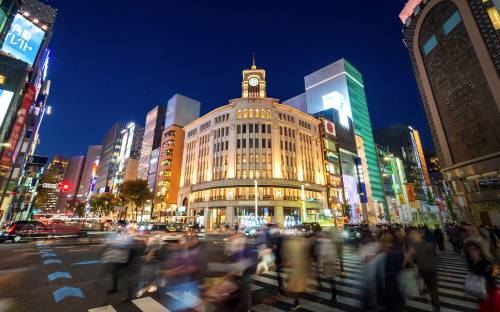From AI-enabled hyper-personalized experiences to the rise of responsive ads via retail media networks to next-gen supply chain automation, the retail industry is transforming on all fronts.
But while retailers face unprecedented disruption across markets, digital enablers and consumers, it is important to remember that this onslaught of change also offers an unparalleled opportunity. Here we offer our take on three ways the retail landscape is changing, the retailers that are at the forefront of these trends, and the steps companies can take to turn fantasy into future success.
A glimpse from NRF 2025












Blended retail: Every space has commercial potential
Long gone are the days of clear delineation between physical and digital channels. Now, retailers are operating in a blended reality, where every space, interaction, and data point has commercial potential.
Take Gap, for example. In a session led by Bill Forbes, Sr. Director of Mobile Software Engineering, we learned that the retailer has more than 1.6 billion visits to its Gap app. Part of Forbes’s job is figuring out how to leverage AI to draw the insights out of those visits and determine the best touchpoints—digital, physical, or somewhere in between—for shoppers. The retailer is now experimenting with a fashion AI system designed to guide shoppers through tasks such as gifting, event styling, and brand discovery while addressing core challenges like accurate sizing, outfit recommendations, and relevant reviews.
The takeaway for retailers is that in this current landscape, the product has become the consumer. Retailers are not selling physical goods so much as meeting consumer needs. With an incredible amount of data at their disposal, the business shouldn’t be around static products, but dynamic, personalized experiences that transcend channels and unite touchpoints.
The new era of connected consumption and contribution
The customer journey is no longer linear. Nor is it rooted in the idea of passive consumption. Instead, retailers are now operating in a dynamic and connected environment—one where the journey is determined by the customer’s needs, not the retailer’s capabilities.
As a result, companies will need to dramatically transform their systems and processes to enable this new paradigm. What used to be back-office functions must expand to include customer-facing applications.
In a keynote session featuring Burberry CEO Josh Schulman, the retail exec outlined a new framework that the company designed to unite merchants, product development teams, and business leaders to help enhance customer engagement. This initiative focuses on reviewing product archetypes, identifying areas for improvement, and aligning investment, merchandizing and distribution strategies to drive growth.
The key for retailers is to connect the business with their consumers as closely as they can. The mandate isn’t just about selling products—it’s about being an authentic part of consumers’ lives.
Know what consumers want
Every retail success story highlighted at NRF had one thing in common: A deep understanding and focus on the consumer. It’s what’s behind Bath & Body Works’ high NPS scores, Foot Locker’s high-impact loyalty program, and Tommy Hilfiger’s 40-year history as one of the world’s most celebrated brands.
On one hand, brands and retailers have an incredible amount of data at their disposal to help them make better decisions. But what may be missing is a broader understanding of how consumer behaviors and preferences are changing.
Filling this gap is the reason for our annual research study by the Capgemini Research Institute, What matters to today’s consumer. Unveiled at NRF 2025, this report highlighted some important findings that retailers can use as a lens when looking at their data.
For example:
- Over half (58%) of consumers have replaced traditional search engines with gen AI tools for product/service recommendations, an 86% increase from 2023
- Two-thirds of shoppers say they would switch retailers due to a lack of sustainability
- Over the past 12 months, online adverts influenced nearly one-third of online purchases
Do any of those data points spark new ideas about what to look for in your own data? Do they serve as a starting point when considering investments in new technologies or capabilities, like AI or retail media networks? Do they give you pause about how to adapt or refine your goals, priorities and approach for 2025 to be more customer-focused?
We believe our report to be a useful tool for retailers to better understand consumer sentiment and behavior. To download a copy, please visit our research page, What matters to today’s consumer: 2025.
What’s next for retailers: 3 steps to guide 2025 and beyond
While every retailer’s journey to the future will be different, we’ve identified three core principles to serve as the foundation of success, guiding businesses as they unlock growth, adapt operations and embrace purpose.
Growth starts at the channel level. As companies consider their future strategies, they must identify where they can drive the greatest influence and impact. One promising opportunity highlighted by our research is the rise of retail media networks—leveraging existing digital and physical infrastructure elements to deliver personalized digital experiences to high-intent customers and forge new connections with brand partners. The value of retail media networks is significant: According to our analysis, Kroger delivered $1.3 billion in operating profit in 2023 from its alternative profit businesses, including Kroger Precision Marketing.
Consumers are now willing to pay 9% of the order value for 2-hour and 10-minute delivery. 65% of consumers consider a 2-hour delivery format a key attribute when they shop, indicating that retailers should consider integrating this into their business models. Is your supply chain up to the challenge? For grocery and mass merch segments, where quick delivery and product availability are paramount, adapting operations to include localized inventory systems will be critical. These enhancements can drive efficiency and ensure customer satisfaction in a highly competitive landscape. The non-linear, dynamic, and multi-directional nature of today’s retail landscape requires a next-gen supply chain. Retailers need to create a holistic strategy that simultaneously takes cost out while also meeting the needs of the customer.
Sustainability and purpose-driven products may be last on our list, but it is certainly not an afterthought for modern shoppers. In fact, our research revealed that consumers want retailers to do more in this area, such as offering clear and compelling information about sustainable choices, providing easy-to-understand information about product sourcing, traceability and nutrition, and creating programs that tackle everyday issues like food waste. As retailers plan for the coming year, they can’t ignore the call to lead with purpose on issues that matter.
Turning science fiction into shopping reality with Capgemini in 2025
As retailers face waves of disruption on all fronts, leaders have a fundamental choice: stay the course or embrace the opportunity for change. In today’s dynamic landscape, those who seize the possibilities of transformation will not only navigate the challenges ahead but also redefine the future of the industry, driving innovation, resilience, and long-term success.
Need help turning your NRF inspiration into action? Our team can help. Set up a consultation with our experts to learn more about how Capgemini can help your organization get the future you want.































































